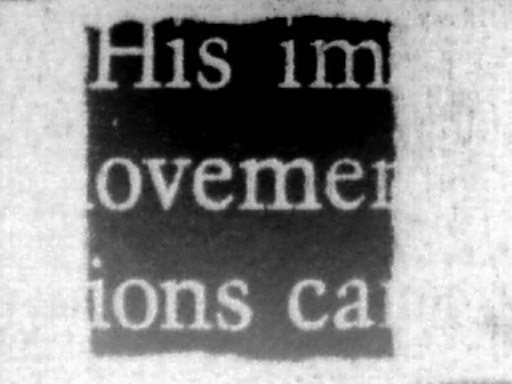
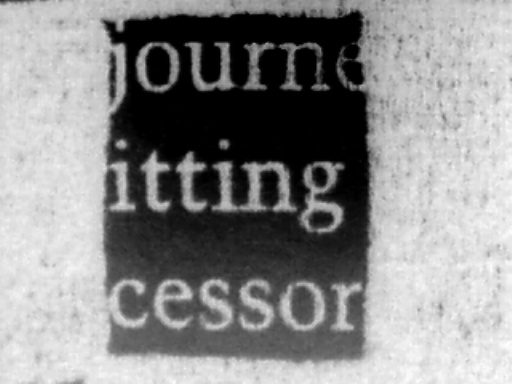
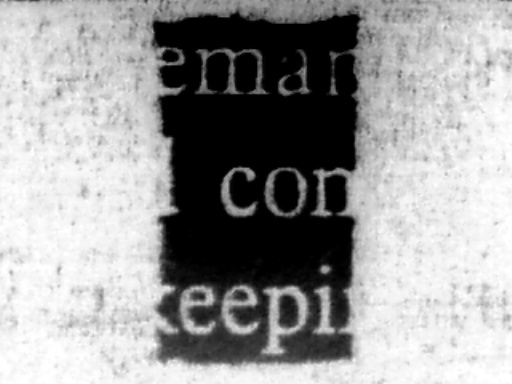
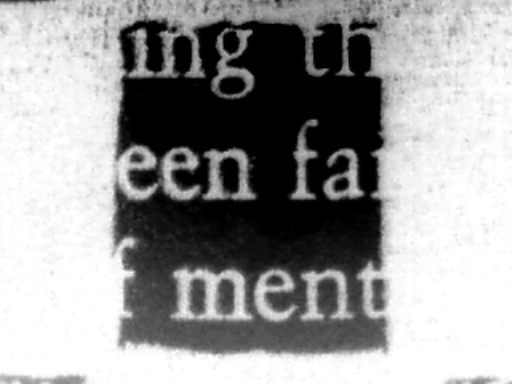

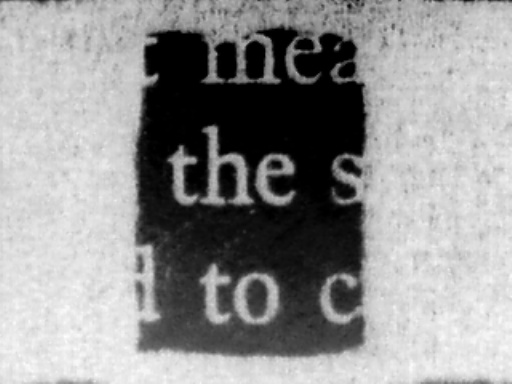
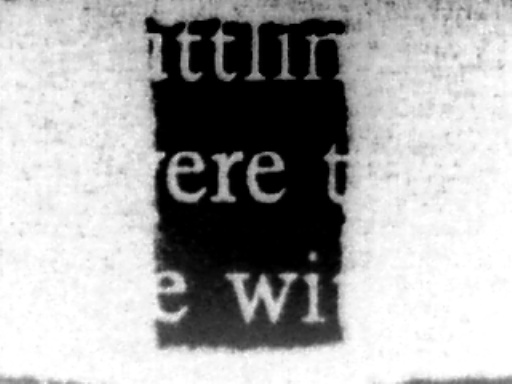
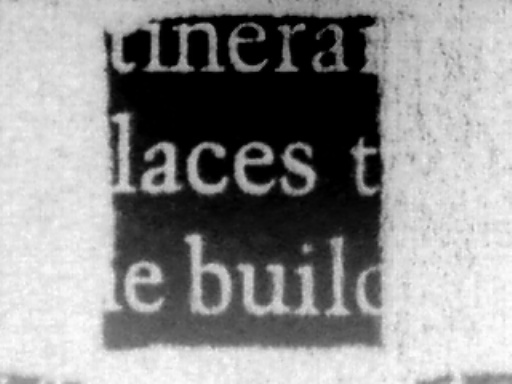
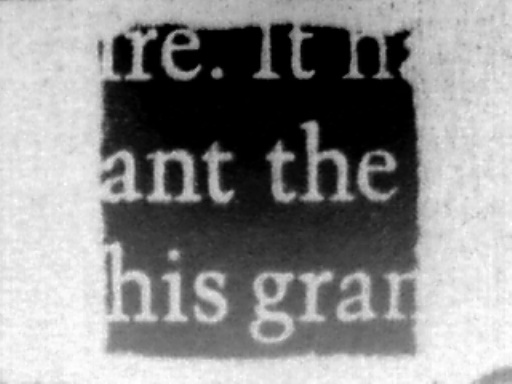
afterword
These works have something "shroud of Turin" about them. Something photographic. In camera (obscura). Something hidden or if not hidden, not meant to be seen (or else not casually). Something "X"—read: "X ray." (A genealogist I know has "rubbings" framed and hanging in her study. These remind me of them. I must tell her, there is something "shroud of Turin" about them.)
It's a slide-show, of course. Chiaro-scuro. These, enigmatic lathes (ainissesthai—"to speak darkly," "to speak in riddles").
Is this a form of writing? Is this art? Is this craft? This is writing that is not writing words. This is writing that is showing words, but not words qua words, that is to say not words as signs (parole), but rather words as symbols.
Not photograph, but eidograph. Not photographic, but eidographic. Not a showing made with light, but a showing of the . . . making conscious the unconscious. The made-visible e-merges (from obscurity—clair-obscur) depicting (a "looking-through," the trans-parens) what takes place below our (superficial) verbal consciousness.
What is eidos? It is language. Langue. The sea of language. The sea of relationality. The great postulated transcendent totality of system. It is mystici corporis. It is antiquus mysticusque. It is prisca sapientia. It is Logos. It is logical space. It is plastic.
Of course this is a depiction. It is a work of art, a form of writing. It is not the real thing. (What is the difference between "art" and "craft"? A craft is the thing itself. Art is always a depiction.)
—Gregory Vincent St. Thomasino
Nico Vassilakis responds:
"eidetic seems a fine enough term. no
need really to defend it - but i understand the desire to define it
in accessable modes. maybe i need to go back through my books, but
i dont see enough about visual writing. visual poetry sure, but visual
writing. twombly and such. it's early maybe im not remembering. id
like to know what it means that vispo has gone abstract. as in, more
abstract that it was/is. it's about juxtaposing, it's about being
in the right "space", it's about alphabetic capabilities,
it's about language inabilities, it's about staring, blurring, and
mostly surprise for me. doing vispo all the time cheapens the experience.
it's an askance thing for me. lexical and creative happenstance. i
dont see how they can go more abstract. does it mean that meaning
is less focused on. that it's becoming more art, less language. sometimes
doing a slideshow, it's fun to have a slide shown out of focus and
slowly, incrementally turn it toward a focus and have people guess
what it is theyre seeing. mostly, always, the original guess is so
wonderfully far from what it's actually showing. basically, the process
of doing the vispo right now is still fun for me. sometimes it bites
and i hate it and i dont do it for months, years. it loses its flavor
and appeal to me if fussed over excessively. i try to learn how and
when to approach vispo with openness. occassionally i get it right.
sometimes it takes me from my text writing. it does that, because
it's easier for me to access. less torment in creating vispo, i think.
staring at textpo creates the potential for vispo."
addendum
At the close of my afterword, I included a statement as to the "difference" between art and craft. I wrote, "A craft is the thing itself. Art is always a depiction." My afterword was written from the perspective of eidetic poetry. My afterword was an impressionistic appreciation (through the lens, if you will, of eidetic poetry). I want to say now that I can also see, and appreciate, the STAMPOLOGUE as a work of "concrete poetry." And from this perspective, I would say that it is not necessarily "a depiction" ("eidographic"), that it may be, and just as well, "nonrepresentational," and maybe even "anti-mimetic." I would refer to Gomringer * speaking about his "constellations," and say of STAMPOLOGUE that each is "a reality in itself," and not an image, or poem, "about."
But what does it mean to say of one thing, this is a "depiction," and of another, this is a "reality in itself"? Is this to deny of the depiction a "reality in itself"? Is this to deny of the "reality in itself" a significance that transcends that "reality"? For instance, let's speak of value (if not of ontology). There is value in the depiction, and there is value in the thing that is a "reality in itself"—there is value in its being a "reality in itself," there is value in that "reality," that "in-itself-ness." There is value in the depiction in that it is a depiction, and in how it is a depiction, and in why it is (said/seen to be) a depiction. When we say there is value in the "reality in itself," we are saying that "reality in itself," as such, is a value, and "as such" is given to mean that it is not about anything other than itself, it does not stand for anything other than itself, it is self-referential, it does not point away from itself but means only in so far as it is (in so far as it is what it is, if not that it is). It has value as an independent object. The object has a certain "objectivity" about it (a certain whereness, though we do not wish to restrict this ubiety to the prison house of the page). (One might say it is "anti-mimetic," although to use the term "anti" would seem to attribute to the object intention, and it does not seem possible to me that a "reality in itself" can have intention, and so to say something is "anti-mimetic" is not to say something about the object but about the purpose of the object, at which point we have gone outside that "reality in itself." And yet, such an object has been, and still is, held to stand for, to speak to or to otherwise illuminate certain artistic and/or social concerns—indeed, we might say it is programmatic, or even theory laden. In which case the "reality in itself" is positioned as an object hypothesis, something given in advance, and accepted without judgment. Given A, is not B analogous to C? This does seem to give the "reality in itself" a significance that transcends that "reality." It does seem to stand for and to point to something outside itself, even if that something outside is just an object hypothesis.) † And herein lies its "concreteness."
But to speak of "concrete poetry" in terms of this understanding of the term "concreteness" is, or so it seems to me, to speak of only a particluar kind of concrete poetry, and a kind of concrete poetry that is possibly more a form of art than of poetry. Why, then, call it poetry? Because it employs words? Why not, "concrete writing," or, as Mr. Vassilakis suggests, "visual writing," or even "language art"? It seems to me, if a form of writing is to partake of the title "poetry," we should be able to discern in it some or other poetic elements. And besides, poetry doesn't have exhibitions, "concrete poetry" has exhibitions. . . .
Rosmarie Waldrop, in her short essay,
"A Basis of Concrete Poetry," †
states a fair proposition: "We do not usually see words,
we read them, which is to say we look through them at their
significance, their contents. Concrete poetry is first of all
a revolt against this transparency of the word. . . ."
She says, "While poetry in general uses the material aspects
of the word as functional in the 'poetic information' process in poems
about whatever subject . . . concrete poetry makes the sound
and shape of words its explicit field of investigation. Concrete
poetry is about words. . . . This does not mean that
concrete poets want to divorce the physical aspects of the word from
its meaning. . . . Words are not colors or lines: their semantic
dimension is an integral part of them. In order to destroy meaning
you would also have to destroy the word as a physical object: you
would have to atomize it into letters, fragments. . . ."
She cites the Noigandres group (whose name is taken from Pound's "Canto
XX") saying, ". . . they seemed to intend exactly that.
. . . But the name is more polemical than the Noigandres manifesto,
which makes clear that these poets intend to work consciously with
all three dimensions of the word, with its 'verbivocovisual' nature.
What they are against is not meaning but representation."
That is to say, they (the Noigandres group, founded by Augusto and
Haroldo de Campos) are not against meaning, but naming, because
to name would be to point away, to a reality outside.
"Their intention," says Waldrop, "is anti-mimetic."
It is important to note, that it is the intention of the poets
that their work should be anti-mimetic, but as for the work itself,
as for that "reality in itself," how, if it is to have meaning,
can it not be in some sense mimetic? To mean, to signify, must
correspond to something other, even if that something other were a
mirror image of itself. "It is a structure which explores
elements of language itself rather than one which uses language to
explore something else. The parallel to the non-representational
painters . . . is explicit." Explicit, maybe, but not complete.
"It is the clear opposite of the Romantic notion of organic form
where content is structure, i.e., where content determines the structure,
the form. With the concrete poets it is the structure which
determines the content. The emphasis is formalist rather than
expressive." And yet, in certain instances, ". . .
a spatial arrangement couples with, or even generates, equivalences
on the level of sound and meaning." It is these "equivalences,"
or what I would call complementarities, ‡
that seem to me to constitute the basis, the basis, of "concrete
poetry" (that is to say, concrete poetry in a generic sense).
§
Waldrop writes, "If the real concrete text only represents itself and is identical with what it shows, we can immediately rule out shaped poems which illustrate a content, e.g., George Herbert's 'Easter Wings' or Apollinaire's 'calligrammes.' Let us also, for the moment, rule out those works which go below the word unit, which become visual works using language elements." Here, I believe, we have the outlines of three distinct types of concrete poetry: Let's call the first type "concrete" and here find that text that is identical with what it shows, this is the anti-mimetic text, the reality in itself, the text that means but does not name. Let's call the next type, "shape," and here find, in addition to the aforementioned, John Hollander's "Swan and Shadow." And let us, but provisionally, call the third type "abstract" and say that here "language elements" are not employed as signals-to-meaning but as symbols suggestive of a system of meaning, a thought structure.
I think we can safely say of all three types that each is, in a sense, a "reality in itself." Moreover, to the degree that each type presents, or is, a spatial arrangement (and to the extent that such presents, or is, or is perceived to be, a shape, a figure, an outline, a pattern, or to be meaningful or significant visually), I think we can safely say of all three types that each is, or presents, an eidos. And on that basis, each type—"concrete," "shape," "abstract"—is, I maintain, a type of "eidetic poetry." But this is not to restrict "eidos" to a form that is perceived only visually, for while we may speak of an eidetic element that is given to instantaneous apprehension, as per to look upon, we can also speak of an eidetic element that is given to conscious intellection, for indeed while it is one thing to see a spatial arrangement, it is another thing to know it as meaningful (and indeed, as significant). ||
Let's consider for a moment the "real concrete text," that instance of concrete poetry that Ms. Waldrop describes. I think we can find a useful clarification in drawing a distinction between this and "poetry in general." Consider, if you will, the case of "poetry in general," I offer here a simple proposition: "The poem" exists on the page, in concrete language, in the form of a deposition ("a putting down"), but the poetry exists, or rather comes into being or is realized, in the mind (via the conscious intellection) of the reader. While "the poem" exists in deposition, the poetry resides with the reader (the "interpretant," let us say). Now where concerns concrete poetry, but specifically the concrete poetry that is that "real concrete text," we can say that the whereness of the poetry of concrete poetry is at the level of that deposition. Now bear in mind, this is not to say of that "real concrete text" that it does not have or show an eidos (a form, an eidetic form), as in fact this eidos is this "text's" entire raison d'etre. ¶
We'll skip over the second type of concrete poetry (the "shaped poem") except to mention that in Herbert's "Easter-wings" and in Hollander's "Swan and Shadow" we find instances of the consummate working out (working together) of both the eidetic and poetic elements (both serve to complete each other, as complementarities, and both are generative the one of the other), and we'll move on to the third type, the "abstract" concrete poem. It may seem a contradiction in terms to speak of an abstract concrete poem, that is unless we bear in mind a keen distinction: Quite simply, concrete is to the senses as abstract is to the mind. Consider: A picture drawn in words, however detailed or explicit, will always be an abstraction (literally a drawing-away, a separation) from nature requiring conscious intellection on the part of the reader, whereas to see a picture is a matter of instantaneous apprehension—it is there (it has whereness), it appears to the senses, it has a material, perceptible existence, it is a "reality in itself." ** We must bear in mind, that the "concrete" in "concrete poetry" has always, above all, been rooted in this distinction, in this sense of instantaneous apprehension—as distinct from the conscious intellection of words. †† There is no contradiction, then, to considering a "concrete poetry" that is both at basis "concrete" and formally abstract (that is at basis flat and particular while formally loft and gerneral). ‡‡
Why has concrete poetry become abstract? Suffice it to say here that we must consider our answer in regard to both the "shaped" and the "concrete" poem, that poets have simply given up on depicting shapes and figures from nature. I don't see this as a matter of talent or ability, but rather, and what is more crucial, as a further outgrowth of the "dissociation of sensibility" which while having its origin elsewhere (and in another time) has never ceased to hold sway (and today, especially among the avant-garde). §§ Today we might call this a fragmentation of sensibility, in which the individual exists in "exploded view" (a consequence, perhaps, of being "analyzed" to pieces, pieces which relate but find their relation to be problematical). Interest has turned inward, has become intra-subjective, in the knowledge of and in search of and in the exploration of a transcendent system of meaning. If not the collective unconscious, the occupation is with relationality as such (the very nature of interrelation, of interdependence, of mutual aver). If it is not to know, and to subdue, Langue—the current, great preoccupation—it is to know and to subdue the self, or perhaps to know and to subdue the world writ large. While willing, and able, to turn from naming, there remains an unwillingness, or are unableness, to turn from meaning. Even the signs turn inward and become symbols, unable to say with certainty but only to suggest (to show, and to tell, indirectly).
I wrote of STAMPOLOGUE, "this is a writing that is not writing words but showing words, words not as signs but as symbols." Looking upon a "slide" from STAMPOLOGUE, the eye, seeking the distal, seeking a midst, seeking information, tends to focus on what appears to be—what is recognized to be—letters, and words, disregarding or paying little attention to the luminescent outskirts (for this is a work of light and shadow). Is it the light, or is it the shadow, that makes these "letters," these "fragments of words," perceptible? It is in the union, this union of light and shadow—the two great and sine qua non principles of visibility and of appearance—that these forms emerge (from obscurity, from eclipse). And what do these forms have to tell us—nothing, they are mute. Though visible, they do not represent any thing in the visible world. And though of language, they do not signal (or speak to or of) any thing in the dialectal, particular world. These forms are a showing—they show language in conceptus, language in situ, language in general, language in ideal form. I wrote of STAMPOLOGUE, these images, these "slides" project an "eidograph." An "eidograph" is a telling by way of showing, it is a "concrete" telling, it is the special poésie of the eidetic poet. The eidograph is a picture of language-in-eidos. St. Thomasino
* Rosmarie Waldrop, "A Basis of
Concrete Poetry," in The Avant-Garde Tradition in Literature,
ed. Richard Kostelanetz (Buffalo, NY: Prometheus Books, 1982), p.
315 ff. All quotes are from this essay.
† Cf. Waldrop, op. cit. Gregory Vincent St. Thomasino
‡ NB: There is a subtle and important distinction between a complementarity and an equivalence. While an equivalence is an equality of value (say, for instance, the illustration of a content), a complementarity is held to supply a complement, to complete or to make complete. The complementarity is in no wise tangential, but is of, or toward, the constitutive essence of the composition (of the object). I maintain, the complementarities of eidetic poetry (if not of all "concrete poetry") are equally (though not necessarily in extent or to degree) and essentially generative one of the other.
§
Cf. The Penguin Dictionary of Literary Terms and Literary Theory,
ed. J. A. Cuddon (3rd ed., 1992). The entry for "concrete
poetry/verse" (p. 184) reads in part, "The object is to
present each poem as a different shape. It is thus a matter
of pictorial typography which produces 'visual poetry.' "
The entry for "pattern poetry" (p. 693) reads in part, "Probably
Oriental in origin, this kind of poem has its lines arranged to represent
a physical object, or to suggest action/motion, mood/feeling; but
usually shape and motion."
Princeton Encyclopedia of Poetry and Poetics,
ed. A. Preminger, F. J. Warnke and O. B. Hardison (enlarged ed., 1974).
The entry for "pattern poetry" (p. 607) reads in part, "Verse
in which the disposition of the lines is such as to represent some
physical object or to suggest motion, place, or feeling in accord
with the idea expressed in the words. The pattern poem, or 'shaped'
poem, first appears in Western-world literature in the works of certain
Gr. bucolic poets, notably in a few poems of Simias of Rhodes (ca.
300 B.C.), later much imitated."
NB: Where concerns complementarities, the operative words
here are in accord with the idea expressed in the words.
Thus the pattern, or shape, and the idea expressed in
the words, must complement or complete each
other, and must be generative the one of the other!
In this sense, "concrete poetry" (and "pattern"
and "shaped") would be synonymous with "visual poetry."
When considering the history of "concrete
poetry" (which is to say, of its forerunners, all which are by
degrees approximations) it is most fruitful to take into account all
the various names by which it has been called. "Concrete
poetry" is a development of carmen figuratum ("shaped
poem"). At this point in time, it would seem that "visual
poetry" (or, "vis-po") is a recent development of concrete
poetry. Each term seems to denote both a generality (a
genus) and a specificity (a species). It would seem that of
all the terms in current usage, "visual poetry" is the most
general, while being also the least informed.
||
As for this eidos (as we speak of it here as the visual component
or complementarity), I think it is this aspect of the concrete-poetry
composition that Mary Ellen Solt is referring to when she says of
concrete poetry (in her footnote to "Moonshot Sonnet") that
it is "supranational, supralingual." And this can
be so because there is no language barrier interfering with the instantaneous
apprehension of the object (its shape or pattern, its spatial arrangement).
Here we find the truly supranational nature of eidetic poetry.
But this is not to reduce eidetic poetry
to its eidetic (i.e., "visual") complementarity only, as
then we would be acknowledging only one half of the equation.
We must also acknowledge its poetic elements, its "lingual"
or language complementarity, as here we find an eidos, a form, of
a different nature, the eidos, or form, of the noun.
¶ Bear in mind the difference between the "concrete" eidos and that eidos that accompanies the text of "poetry in general." In the case of "poetry in general," here we find an eidos that is properly understood to be a margin and indentation pattern, this pattern or scheme, or, template (I call this the "poetic template") signals to the reader a number of things, least of which is "I am a poem." Compare the outward eidetic form of a sonnet to, say, Solt's "Moonshot Sonnet" or to Christian Morgenstern's "Fisches Nachtgesang" or to this untitled piece by Jukka-Pekka Kervinen.
**
NB: The forms found in the first type of concrete poetry are rarely
found in nature, unlike those found in the second type, which
usually are. This is important if the "forms" found
in the first type are to be considered "nonrepresentational," and
a "reality in itself," and not a depiction (not
mimetic) from nature! We may ask, then, just what
kind of forms are to be found in the first type of concrete
poetry, in the "real
concrete text"? I don't think it will be an imposition
on these works (to the contrary, it may increase them) to say of
these forms that they are Platonic. (Cf. Plato, Philebus,
51 c-d. "I mean not the figures of creatures in real life.
I mean a straight line, a curve and the plane and solid figures.
These are not realtively beautiful, but are beautiful in
their very nature.") And we should not be surprised to
find in the third type, in the "abstract" type, that
the same kind of forms apply.
"Concrete is to the senses
as abstract is to the mind" can also be conceived of
as "concrete is to what shows as abstract is to what
tells." In the preamble to my e-book Go
Mirrored (xPress(ed), 2003) I present this analogy: "We
might say, then, that the 'visual' component of the concrete poem
is to the analogue clock what the semantic component is to the digital
clock, in that the one shows what the other tells."
Gregory Vincent St. Thomasino
†† Compare/contrast this idea of "instantaneous apprehension" with Pound's authoritative assertion on the Image in the "Imagist" poem ("An 'Image' is that which presents an intellectual and emotional complex in an instant of time. . . . It is the presentation of such a 'complex' instantaneously. . . .") and with Richard Kostelanetz's notion of the "imaged word."
‡‡ The word basis has the Greek root bainein, "to go." To be at basis is to be at "the get go," to be "from the word go" (or, "from the very beginning").
§§
Cf. T. S. Eliot, "The Metaphysical Poets" (1921).
A voluminous and authoritative literature
exists seeking to explain and to explore, to locate and to situate
the "dissociation of sensibility." I think this condition
is real and is a predisposition (a gene-determined characteristic?)
of the human condition (and so it does not apply to poets only).
I think to say of someone that he can "compartmentalize"
is to say that he can "dissociate" (and for better or worse,
although I wonder just what good this has beyond an immediate situation,
albeit it is spoken of as a "talent" or as some sort of
"superior ability"). I think for the poet (and for
poetry) the results can be unfortunate, if not disastrous. Instinct
dictates that an associative principle be sought, but if this cannot
be found in the sensibilities, it can be found in some or other ideology.
(Both require work, but for the one the work is inward, for
the other it is outward.) And while the one makes for a keen
individuality, the other makes for a collectivistic mentality—and
while this wears the coat of arms of "the other," its strength
is that it is one among many (or, a sort of legitimacy by association).
The "dissociation of sensibility" is reinforced time
and again, I think this the scholars will agree upon. But there
is also an "association of sensibility," an "associative"
sensibility, an "associative" type. What of this associative
type? This associative person? The associative poet?
Is he given to suffer his times? The associative poet sees the
complementarities that exist in the world, and in his poetry he recreates
them, he dipicts them, he celebrates them, he exalts them with joy,
pride and confidence. This is his special mimesis, his special
ekphrasis. When I speak of The Postmodern Romantic, I speak
of the associative poet whose time is a time of dissociation.
I speak of the associative poet whose associative sensibility stands
against the dissociation of sensibility. (It pays to consider
the term "dissociation of sensibility" beside the earlier
term "self-estrangement.") Gregory
Vincent St. Thomasino

Nico Vassilakis
from STAMPOLOGUE
an
afterword—with a response by Nico Vassilakis
and an addendum on eidetic poetry—follows the text